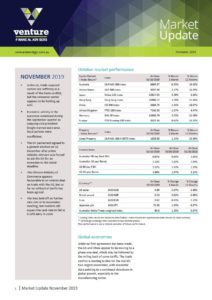The Pulse

- In the US, trade-exposed sectors are suffering as a result of the trade conflict, but the consumer sector appears to be holding up well.
- Economic activity in the eurozone weakened during the September quarter as outgoing ECB president Draghi warned euro-area fiscal policies were insufficient.
- The UK parliament agreed to a general election on 12 December after prime minister Johnson was forced to ask the EU for an extension to the Brexit deadline.
- The Chinese Ministry of Commerce appears favourable to an interim deal on trade with the US, but so far no rollback of tariffs has been agreed.
- The RBA held off on further rate cuts at its November meeting, but markets still expect the cash rate to fall to 0.50% early in 2020.
Global economies
While no firm agreement has been made, the US and China appear to be moving to a phase one deal, which may be followed by the rolling back of some tariffs. The trade conflict is starting to bite for the world’s two largest economies, with economic data pointing to a continued slowdown in global growth, especially in the manufacturing sector.
Australia
The Reserve Bank of Australia cut rates to a record low 0.75% in early October, it’s third move since June. The aggressive approach taken by the RBA over recent months is partly in response to the global trade uncertainty and the domestic housing sector slowdown. Easing policy globally and a rising unemployment rate locally made the case for an easing bias a relatively simple one. However, the economy’s response to the easing cycle, along with moves by APRA to free up some lending capacity and the government’s tax cuts, has been subdued, at least to date.
US
October saw a détente in the US-China trade conflict, as President Trump announced the suspension of tariff hikes on US$250 billion of Chinese goods, while China agreed to buy $40–50 billion in US farm products. The ‘agreement in principle’ does not roll back the existing tariffs that China and the US have in place.
Europe
The IHS Markit Eurozone Composite PMIs present a grim picture of slowing growth and declining inflation. The index suggests that activity in the eurozone will be lucky to have grown by 0.1% in the September quarter, with flagging momentum at the start of the December quarter.
China
The Chinese economy slowed to an annual growth rate of just 6.0% in the September quarter—the slowest pace in almost 30 years. However, to put this growth in perspective, the Chinese economy is more than 2.5 times the size it was in 2009, while GDP per capita has doubled over this period. Over the past 12 months a downturn in industry, trade and construction underpinned the weaker GDP result, partly offset by solid service sector performance.
Asia region
As in several other countries, weakness in Japan’s manufacturing sector is being offset by continued strength in the services sector. The Jibun Bank Japan Services PMIs suggest GDP growth in the September quarter may come in at around an annualised 1.0%. The Bank of Japan’s quarterly Tankan survey indicates that sentiment among large manufacturers fell to its lowest level in more than six years, while the external sector remains precarious.